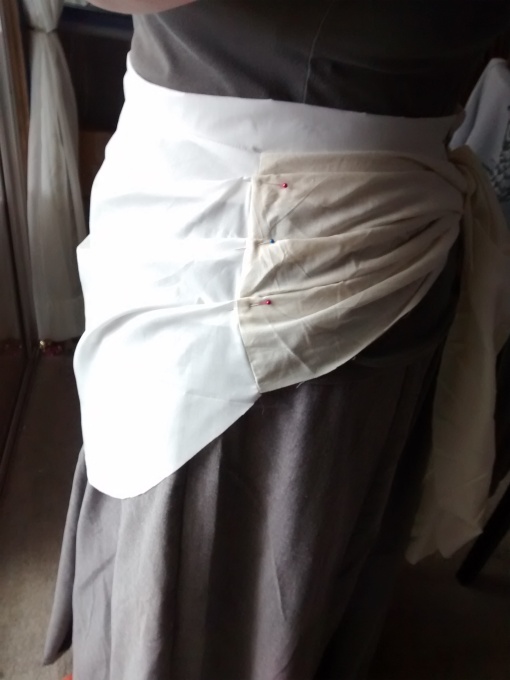I don’t know why there is this decades long conspiracy to not give women pockets or to give us tiny, non-functional, or purely decorative pockets. You know the ones. It’s the pants with fake pockets in front, or worse, the “real ones” that are only two inches deep. It’s the jacket that only has pocket flaps. Or the expensive slacks with the well made pocket welts that appear to be stitched shut, but, when opened, don’t go anywhere. This has been going on for ages. I recently acquired a Victorian jacket that has a mysterious slit in one of the front seams. On the inside you can tell that it’s intentional. Turns out it’s for a pocket watch. It’s not a watch pocket, but a watch slit. Weird.
We are constantly told women didn’t have pockets historically. None in Victorian times (pocket watch slit not withstanding). None in the Elizabethan era. No colonial female pockets. But that just isn’t so. There are many examples in extant garments, paterns and paintings, showing conclusively that Women. Had. Pockets.
My theory is that, as various parts of our figures were being hidden in volumes of fabric, so were our pockets. If you can’t see them, clearly we must not have needed, wanted, or used them, right? And of course, what high class woman woman of leisure would need to do something so vulgar as to carry something herself. I also suspect that many women’s skirts and dresses, work-a-day ones that would have been worn out or remade, didn’t survive as often as the fashionable gowns that didn’t strictly need pockets. There are plenty of examples of women’s historical pockets out there, should you care to look. Check out this article on making your own at the V&A and one version of the sexist history of pockets via Medium.
For my Dickens Fair costume I decided to make a quilted, tie on, pocket. I did so because, 1. I don’t want to buy an appropriate bag, which were in vogue at that time, 2. I don’t want to make a appropriate bag, and 3. I don’t want to carry anything. I happen to think every garment should have a plethora of pockets. I chose to make an 18c size and shape quilted pocket because it’s pretty big (16″ x 10″) and I wanted to try out free-motion quilting (I’d never quilted a damn thing until the day before – I’ll get to why I tried it in a later post).

Some ex-sheets are not too bad a fabric choice for Victorian. The bias tape was removed from the bolero I plan to wear. I used all but maybe 6″ of it. Hooray for upcycling.

Huh, my fabric is sort of a combo of the middle top and left second row… I believe this image comes from Vintage Dancer.

My random quilting is ok if you don’t look at the various stitch lengths. There was no plan to the pattern and I basically went as fast as I could without breaking threads. I did learn that free quilting works best on my Kenny with the feed dogs up.

The finished pocket! I took my time and put the binding on correctly #notlazysewing
And there you have it. I have a historical pocket!. To use it, I’ll need pocket slits in my skirt and petticoats.

Dummy wearing a black dress to cover the fact that she’s disintegrating, my Laughing Moon pattern late Victorian waist cincher in silk and coutil, a bumpad and the pocket.
Next time: Son of Ugly Puffer





















